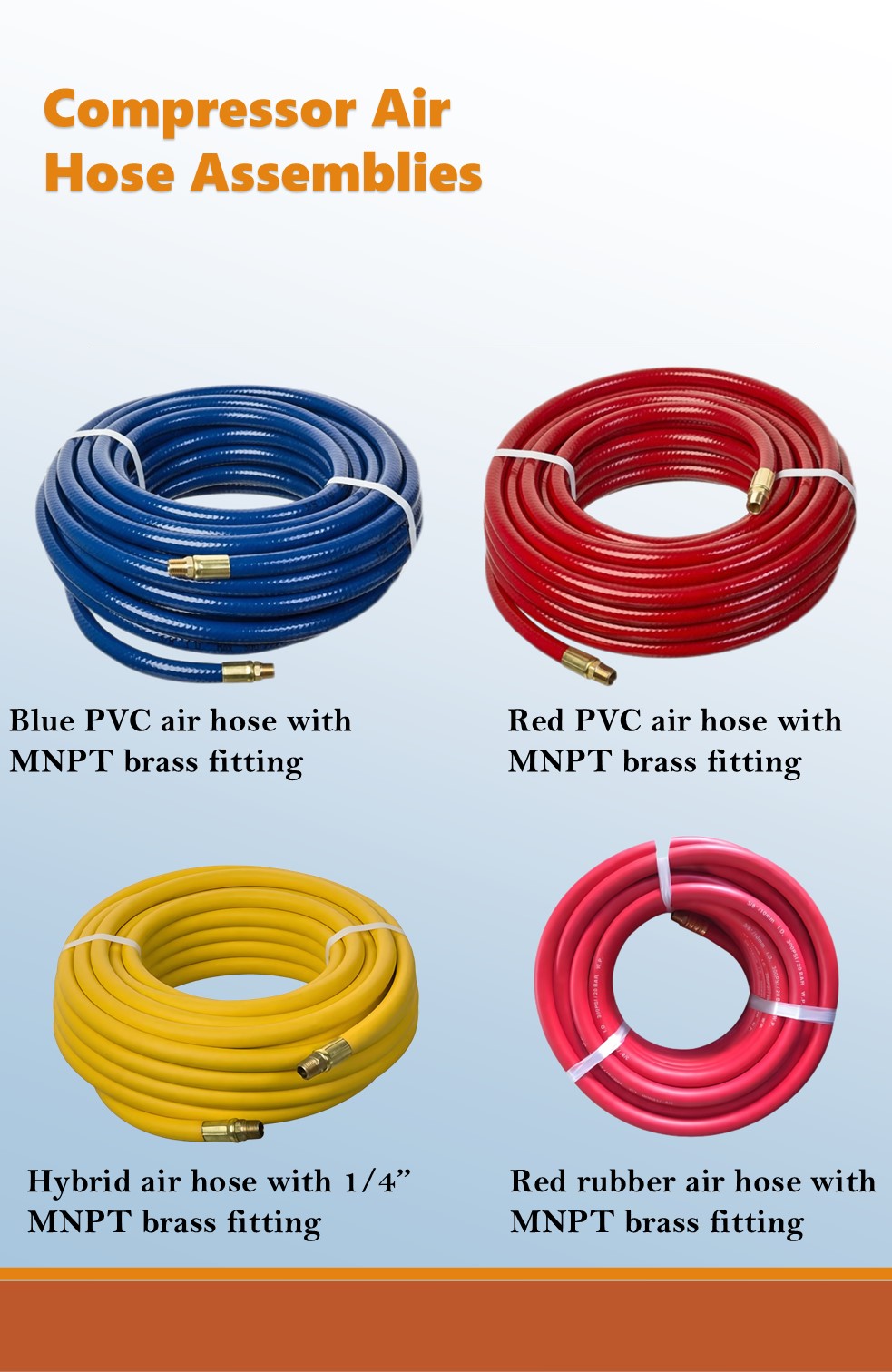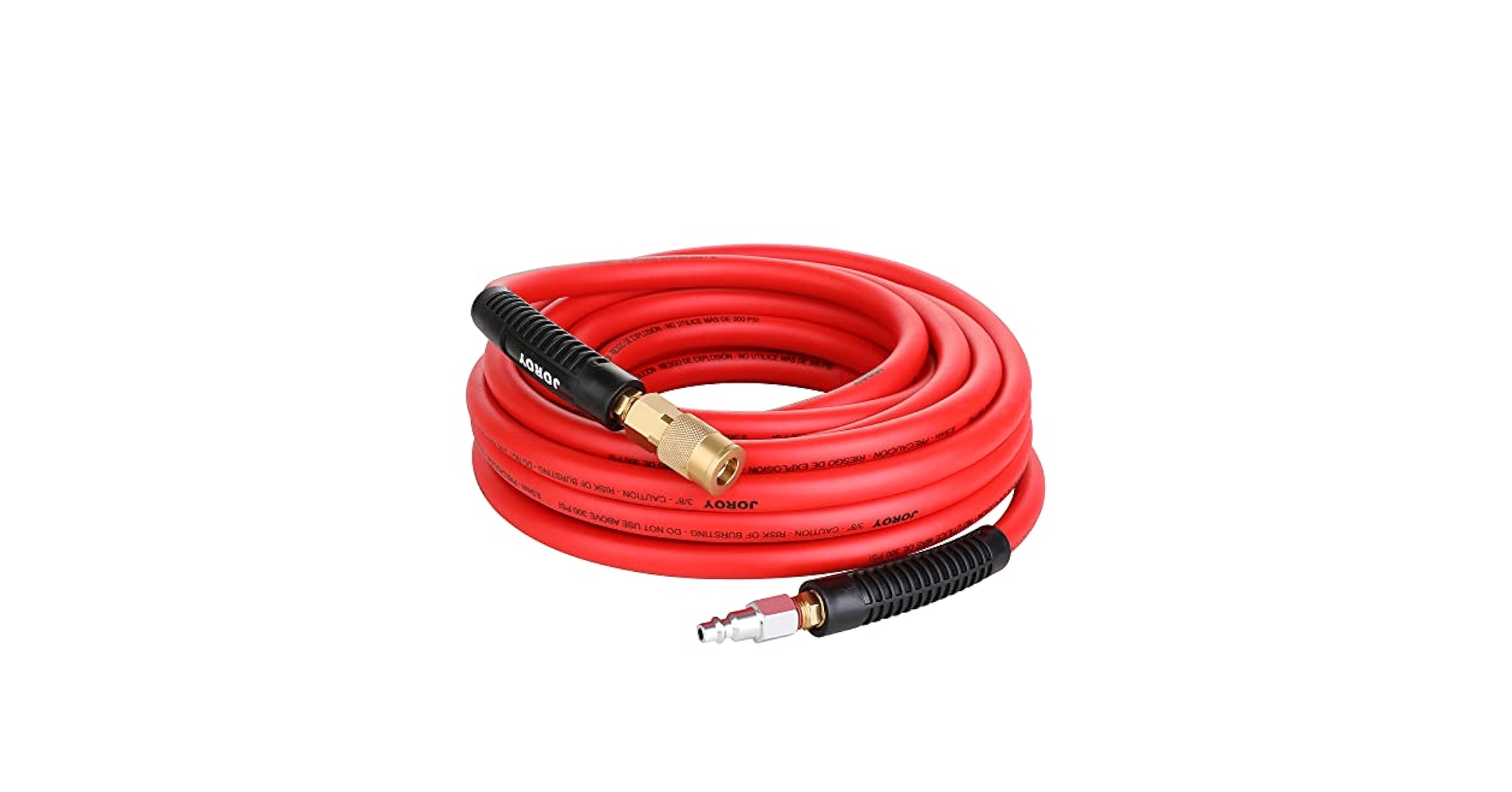Choosing the right air compressor hose size can make a huge difference in how well your tools work and how smoothly your projects go. If you’ve ever struggled with weak air pressure or hoses that just don’t fit right, you know how frustrating it can be.
This guide will help you understand exactly what hose size you need for your air compressor, so you get the best performance every time. Keep reading to discover simple tips that will save you time, money, and stress on your next job.
Types Of Air Compressor Hoses
Air compressor hoses come in many types. Each type suits different jobs and tools. Choosing the right hose helps air flow smoothly. It also prevents damage and saves energy.
Understanding the types helps you pick the best hose for your needs. Below are the main factors that define hose types.
Material Variations
Hoses are made from various materials. Rubber hoses are strong and flexible. They resist heat and wear well over time.
Polyurethane hoses are light and easy to move. They do not kink easily and last long. PVC hoses are cheaper but less flexible. They work well for light jobs.
Common Lengths
Hose length affects how far you can work from the compressor. Common lengths include 25, 50, and 100 feet. Short hoses are easier to handle but limit reach.
Longer hoses allow more freedom but may lose pressure. Choose a length that fits your workspace and tool needs.
Diameter Options
Hose diameter impacts air flow rate. Common sizes are 1/4 inch, 3/8 inch, and 1/2 inch. Smaller diameters suit small tools and light work.
Larger diameters deliver more air for heavy-duty tools. Pick a diameter that matches your compressor’s output and tool requirements.
Choosing The Right Hose Diameter
Choosing the right hose diameter is key for efficient air compressor use. The hose size affects how well air flows through it and powers your tools. Picking the wrong diameter can cause problems like low pressure or slow tool operation. Understanding how hose diameter impacts your setup helps you get the best results.
Impact On Airflow
Hose diameter controls the amount of air that moves through the hose. A larger diameter allows more air to pass with less resistance. Smaller hoses restrict airflow, which can slow down your tools. Proper airflow ensures tools run smoothly and work faster.
Matching Tool Requirements
Each tool needs a specific air volume and pressure to work well. Check the tool’s manual for its hose size recommendation. Using a hose that is too small can starve the tool of air. A hose that is too big may be bulky and hard to handle.
Pressure Considerations
Air pressure drops over long hoses and narrow diameters. Larger diameter hoses keep pressure steady over distance. Low pressure can cause tools to lose power or stop working. Choose a hose diameter that maintains proper pressure for your tasks.
Measuring Hose Size Accurately
Measuring hose size accurately is essential for the best air compressor performance. A wrong size can cause leaks and reduce air flow. Knowing the exact size helps you pick the right hose. This makes your work easier and saves money.
Inner Vs Outer Diameter
The inner diameter (ID) is the hollow part inside the hose. It controls how much air moves through. The outer diameter (OD) is the full width, including the hose wall. ID is more important for air flow. OD matters for fitting connections and clamps.
Tools For Measurement
Use a caliper for the most accurate measurements. A ruler or tape measure works but is less precise. Measure the hose when it is clean and straight. Check both ID and OD to ensure the right fit. Digital calipers give fast and clear readings.
Avoiding Measurement Errors
Do not measure a bent or twisted hose. Avoid measuring over dirt or paint. Take multiple measurements at different points. Use the average number for best results. Always measure the hose at room temperature for accuracy.
Effects Of Hose Size On Compressor Performance
The size of an air compressor hose affects how well the compressor works. Choosing the right hose size can prevent problems and keep the system running smoothly. Hose size impacts pressure, power, and the overall efficiency of the compressor.
Pressure Drop Issues
A small hose size causes more pressure drop along the line. Pressure drops reduce the force available at the tool or machine. This means the compressor has to work harder to maintain pressure. Large hoses help keep pressure steady and reduce loss.
Efficiency And Power Loss
Using the wrong hose size wastes energy. The compressor uses extra power to push air through narrow hoses. This reduces efficiency and increases energy costs. Choosing the right hose size saves power and keeps the system efficient.
Optimal Hose Lengths
Long hoses increase pressure drop regardless of size. Keeping hose length short helps maintain good pressure. If long hoses are needed, use larger diameters to reduce loss. This balance improves compressor performance and tool operation.
Common Hose Size Standards
Choosing the right air compressor hose size depends on common standards. These standards help you find the correct hose for your tools and machines. Understanding these sizes avoids leaks and pressure drops. It also makes sure your equipment works well and lasts longer.
Imperial Vs Metric Sizes
Air compressor hoses come in two main size types: imperial and metric. Imperial sizes use inches. Metric sizes use millimeters. For example, a 1/4-inch hose is about 6 millimeters in diameter. Knowing both types helps when buying hoses worldwide. Always check the size unit before purchasing.
Industry Norms
Industries follow certain hose size norms to keep work smooth. Common sizes include 1/4 inch, 3/8 inch, and 1/2 inch in imperial. Metric sizes often are 6 mm, 9 mm, and 12 mm. These sizes fit most air tools and compressors. Using standard sizes reduces fitting problems and downtime.
Compatibility Tips
Match the hose size with your compressor and tool fittings. Check the internal diameter of the hose. The hose must handle the air pressure safely. Use adapters if your sizes differ but avoid too many connectors. Always test your setup to ensure no air leaks. Proper size improves air flow and tool performance.

Credit: www.amazon.ca
Specialized Hose Sizes For Different Applications
Air compressor hoses come in many sizes. Each size serves a special purpose. Choosing the right size is key for good performance. Different jobs need different hose sizes. This helps tools work well and last longer.
Specialized hose sizes fit various work areas. These include cars, factories, and home workshops. Each place needs a hose that matches the tools and pressure demands.
Automotive Use
Cars and trucks often use small to medium hoses. These range from 1/4 inch to 3/8 inch. They fit air tools like impact wrenches and spray guns. Smaller hoses are lighter and easier to handle. They deliver enough air for quick repairs and painting.
Industrial Settings
Factories need larger hoses. Sizes of 1/2 inch to 1 inch are common. Big hoses carry more air to heavy machines. They must handle high pressure and long distances. Strong, thick hoses prevent air leaks and wear.
Home Workshops
Home use calls for flexible, easy hoses. Many choose 1/4 inch hoses. These work well with small air tools. They are light and easy to store. Home hoses need to be safe and simple to use.
Maintenance Tips For Air Compressor Hoses
Maintaining air compressor hoses is key to keeping your equipment safe and working well. Regular care helps avoid leaks and breaks. It also extends the hose life and saves money on replacements.
Simple steps can protect hoses from damage and wear. Follow these tips to keep hoses in top shape and ensure smooth operation.
Regular Inspection
Check hoses often for cracks, holes, or leaks. Look at the connections for tightness and wear. Replace any damaged parts quickly to prevent failure.
Inspect hoses before and after each use. Early detection of problems avoids bigger repairs later.
Preventing Wear And Tear
Avoid sharp bends and kinks. Use hose guides or reels to prevent twisting. Keep hoses away from hot surfaces and chemicals that cause damage.
Use the right hose size for your compressor to reduce strain. Handle hoses carefully to avoid cuts or abrasions.
Storage Recommendations
Store hoses in a cool, dry place, away from sunlight. Coil hoses loosely to prevent bends and cracks. Avoid stacking heavy items on hoses during storage.
Proper storage keeps hoses flexible and ready for the next use. It also prevents premature aging and damage.

Credit: www.alibaba.com
Upgrading And Replacing Hoses
Upgrading and replacing air compressor hoses is important for safety and performance. Old or damaged hoses can cause air leaks. This lowers the efficiency of your compressor system. Choosing the right size and material improves air flow and durability. Proper installation ensures the hose works well and lasts longer.
Signs You Need A New Hose
Look for cracks, cuts, or holes on the hose surface. Air leaks or loss of pressure during use are clear signs. A hose that feels stiff or brittle may break soon. Check for worn connectors or fittings that do not hold tightly. If the hose is old and worn, replacing it is safer.
Choosing Better Materials
Select hoses made from durable materials like reinforced rubber or polyurethane. These resist wear, abrasion, and weather better than cheap plastic. Consider the hose’s flexibility for easy handling and storage. Choose materials that match your working pressure and temperature needs. Quality materials extend the hose’s life and improve safety.
Installation Best Practices
Install hoses without sharp bends or kinks to prevent damage. Use proper fittings that match the hose size for tight connections. Avoid dragging hoses on rough surfaces or exposing them to chemicals. Store hoses in a dry, cool place when not in use. Regularly inspect hoses after installation to catch issues early.

Credit: www.amazon.com
Frequently Asked Questions
What Are The Common Air Compressor Hose Sizes?
Common air compressor hose sizes include 1/4 inch, 3/8 inch, and 1/2 inch diameters. These sizes suit various tools and pressure requirements efficiently.
How Does Hose Size Affect Air Compressor Performance?
Larger hose sizes reduce air pressure loss and increase airflow. Smaller hoses may limit tool efficiency and cause pressure drops.
Which Hose Size Is Best For Pneumatic Tools?
A 3/8 inch hose size works well for most pneumatic tools. It balances airflow and flexibility for optimal tool performance.
Can I Use A Larger Hose Than Recommended?
Using a larger hose can improve airflow but may be less flexible. Ensure the hose fits your compressor and tools properly.
Conclusion
Choosing the right air compressor hose size matters. It affects air flow and tool performance. Smaller hoses may limit air supply. Larger hoses can be harder to handle. Match the hose size with your tool needs. This ensures smooth work and saves time.
Remember, the right hose keeps your compressor efficient. Take time to pick what fits best. Your projects will run easier and better. Simple steps lead to better results every time.

